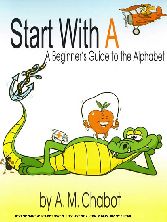Suchen und Finden
Introduction (S. V-VI)
Start with A is a reproducible book designed to introduce learners to the alphabet and guide them toward reading and writing. Each chapter is four pages long, and follows a similar pattern. The first feature of Start With A is each unit concentrates on a particular letter of the alphabet. There are 26 units in the book: A to Z. Each unit presents ten vocabulary words. Words often used in teaching the alphabet were chosen.
The letter in focus may appear anywhere in the vocabulary word (e.g. For the letter A: arm, hat, banana, etc.). The vocabulary words are introduced by ten clearly labeled illustrations. Immediately, the learners can begin to associate the printed word with the pictures in preparation for meeting many of these words in their reading texts. The first task for you and your students is to study the drawings and their associated words. It is strongly recommended that you allow your students to hear each word repeated several times, and allow your students a chance to say the words out loud. You may decide to spell each word for your students. After studying the ten drawings, the students then circle all the examples of the letter in focus for that unit. Start With A gives students ample opportunity to print the letters they are learning. In the first printing exercise the learners are guided in the formation of the letters by shadow letters and numbered strokes. Their next opportunity is a cloze exercise. Here the students are given vocabulary words from the unit and they need only fill in the blanks with the letter in focus for that lesson.
From there, the learners practice, with shadow letters and numbered strokes, writing whole words from the unit. Finally, in another exercise, the students are given a chance to print the letters without shadow letters or numbered strokes. It is hoped that with this amount of exposure and practice, learning will be both enjoyable and effective. Other exercises include a matching the word with the picture exercise. For working with sounds, in another exercise the learners are presented with several of the illustrations from the unit. The students are asked to identify those that begin with the letter in focus.
This should help them to associate the letter with the sound or sounds in some cases. A more challenging part of Start With A is a Tic-Tac-Toe exercise. This task gives the learners a chance to apply their cognitive skills in identifying three related items on a Tic-Tac-Toe grid. The grid contains nine words and the students must decide which three have the most in common. You should read the words aloud to your students, and make sure they know the meaning of each word. If the learners need help with a particular puzzle, there is a clue printed upside down below each grid. Another feature of Start With A is a connect the dots drawing at the end of each unit. Rather than use numbers, the learners are given a playful opportunity to follow the letters of the alphabet in their proper order to complete the picture. With Start With A, repetition and discovery work hand in hand as the learners acquire new and valuable knowledge.
Enjoy!
A. M. Chabot
Alle Preise verstehen sich inklusive der gesetzlichen MwSt.








